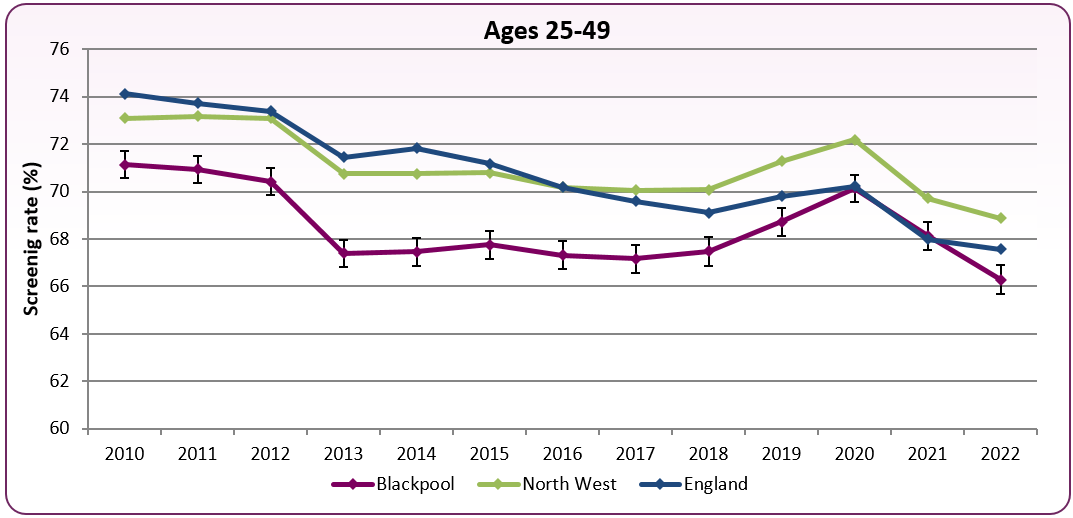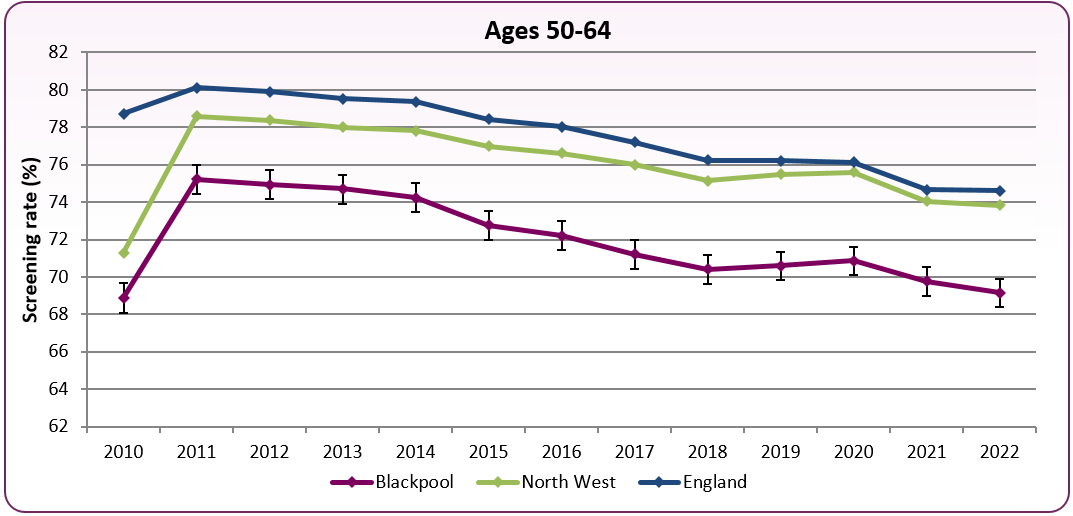Cervical Cancer
Last Modified 30/11/2023 09:17:04
Share this page
Introduction
Cancer Research UK provides a brief guide to cervical cancer that includes information about symptoms, early detection, screening for cervical cancer and possible risk factors.
Facts and figures
Incidence of cervical cancer
In Blackpool each year there are approximately 10 new cases of cervical cancer identified. Between 2018 and 2020 the rate of cervical cancer incidence in Blackpool was 13.6 per 100,000 population (directly standardised rate). This is statistically similar to the England rate (9.3).
Mortality from cervical cancer
In Blackpool there are approximately three deaths annually due to cervical cancer. The five-year (2016 to 2020) mortality rate of cervical cancer in Blackpool (females, all ages) is 3.9 per 100,000 population (directly standardised rate). This is statistically similar to the rate for England (2.5). Blackpool had an unusually high level of cervical cancer deaths in 2015 (10 deaths), although the count has reduced back to the average.
Cervical cancer screening
The NHS administers a national cancer screening programme aimed at detecting early symptoms of cervical cancer. Cervical cancer screening is included as a local authority level indicator within the Public Health Outcome Framework. The definition of this cervical cancer screening coverage measure is the proportion of women in the resident population eligible for cervical screening who were screened adequately within the previous 3.5 years or 5.5 years, according to age (3.5 years for women aged 25-49 and 5.5 years for women aged 50-64).
In 2022, Blackpool achieved a screening coverage rate of 66.3% for women aged 25 to 49, and 69.2% for women aged 50 to 64 (figure 1). Eligible women (25-64-years) living in Blackpool are significantly less likely to be screened for cervical cancer than the North West region or England as a whole.
Following a similar pattern to national and regional trends during the COVID-19 period, Blackpool's coverage rate fell in 2021 to 68.1% for 25-49-year-olds and 69.8% for 50-64-year-olds. This downturn in screening coverage, caused by a combination of reduced screening provision and uptake, may impact on both cervical cancer incidence and mortality over the COVID recovery period.1,2,3
Figure 1 - cervical cancer screening coverage trends: 25-49-year and 50-64-years (2010-2022)

 Source: Public Health Outcomes Framework
Source: Public Health Outcomes Framework
Risk factors
Cancer Research UK has compiled a summary of risk factors and causes of cervical cancer.
Masson, H. (2021) Cervical pap smears and pandemics: The effect of COVID-19 on screening uptake & opportunities to improve. Womens Health (London), 2021; 17.
Davies, J.M., Spencer, A., MacDonald, S. et al (2022) Cervical cancer and COVID - an assessment of the initial effect of the pandemic and subsequent projection of impact for women in England: A cohort study. British Journal of Gynaecology 129;7: 1133-1139.
Massad, L.S. (2022) Impacts of the COVID-19 pandemic on cervical cancer will be severe (mini commentary), British Journal of Gynaecology 129;7:1140-1140.